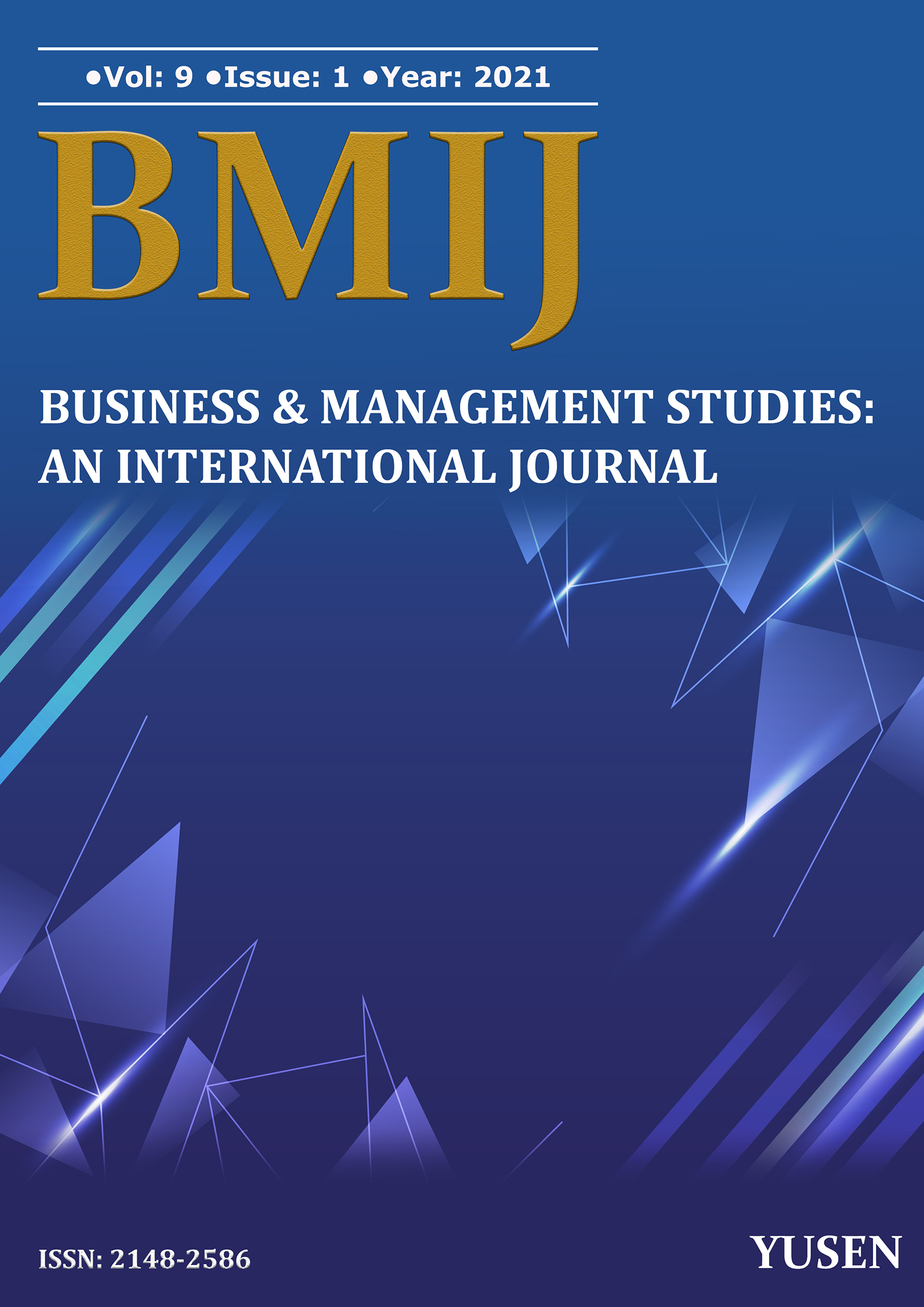
Yayınlanmış 25.03.2021
Anahtar Kelimeler
- ISO 9001, Zaman Serileri Analizi, Üstsel Düzeltme, Kanada, ABD
- ISO 9001, Time Series Analysis, Exponential Smoothing, Canada, USA
Nasıl Atıf Yapılır
Telif Hakkı (c) 2021 Burhan Başaran

Bu çalışma Creative Commons Attribution-NonCommercial-NoDerivatives 4.0 International License ile lisanslanmıştır.
Nasıl Atıf Yapılır
Öz
Dünya genelinde kullanım alanı en fazla olan standart ISO 9001’in gelecekteki gelişimine yönelik çalışma sayısı sınırlıdır. Bu araştırmanın amacı G20 ülkelerinin 1993-2019 yılları arasında kaydedilen ISO 9001 sertifika sayıları değerlendirilmiş ve 2020-2026 yılı sertifika sayıları ise Eviews 11 programı kullanılarak tahmin edilmiştir. Tahmin hesaplamasında time series regression ve exponential smoothing yöntemlerine ait modellerden faydalanılmıştır. Araştırmada 2026 yılı için tahmin edilen sertifika sayısına göre ülke sıralaması, Hindistan (43947), Brezilya (22744), Kanada (11814), ABD (37235), Meksika (9977), Arjantin (8433), Rusya Federasyonu (1540), Avustralya (5072), Güney Afrika (4626) ve Suudi Arabistan (2785) olarak belirlenmiştir. Ülkelerin 2019 yılı sertifika sayısı sıralaması referans alındığında 2026 yılında Kanada, Rusya Federasyonu, Avustralya ve Meksika’nın pozisyonunda değişiklikler beklenmektedir. 2026 yılında Avustralya ve Rusya Federasyonu’nın sertifika sayısında azalma öngörülmüştür. Araştırmanın özellikle belirlenen dokuz ülkenin ISO 9001 performansının ve gelecekteki trendin nasıl şekilleneceğinin anlaşılmasına katkıda bulunacağı düşünülmektedir.
Referanslar
- Altamirano, M. (2019). Economic vulnerability and partisanship in Latin America. Latin American Politics and Society, 61(3), 80-103.
- Anderson, S. W., Daly, J. D., & Johnson, M. F. (1999). Why firms seek ISO 9000 certification: regulatory compliance or competitive advantage?. Production and Operations Management, 8(1), 28-43.
- Barros, M. V., Ferreira, M. B., do Prado, G. F., Piekarski, C. M., & Picinin, C. T. (2020). The interaction between knowledge management and technology transfer: a current literature review between 2013 and 2018. The Journal of Technology Transfer, 45, 1585-1606.
- Başaran, B. (2016). The effect of ISO quality management system standards on industrial property rights in Turkey. World Patent Information, 45, 33-46.
- Başaran, B. (2018). Integrated management systems and sustainable development. In L. Kounis (Ed.), Quality Management Systems-a Selective Presentation of Case-Studies Showcasing Its Evolution (pp. 1-19). InTechopen, London. ISBN: 978-953-51-3920-1
- Cabecinhas, M., Domingues, P., Sampaio, P., & Arezes, P. (2019). Revisiting diffusion models: Portuguese integrated management systems evolution. In P. M. Arezes, J. S. Baptista, M. P. Barroso, P. Carneiro, P. Cordeiro, N. Costa, R. B. Melo, A. Sérgio Miguel, & G. Perestrelo (Eds.), Occupational and Environmental Safety and Health (pp. 661–675). Springer, Cham. ISBN: 978-3-030-14729-7
- Casadesus, M., Gime, G., & Heras, I. (2001). Benefits of ISO 9000 implementation in Spanish industry. European Business Review, 13,(6), 327-336.
- Casadesus, M., Marimon, F., & Heras, I. (2008). ISO 14001 diffusion after the success of the ISO 9001 model. Journal of Cleaner Production, 16(16), 1741-1754.
- Clougherty, J. A., & Grajek, M. (2014). International standards and international trade: Empirical evidence from ISO 9000 diffusion. International Journal of Industrial Organization, 36, 70-82.
- Corbett, C. J., & Kirsch, D. A. (2001). International diffusion of ISO 14000 certification. Production and Operations Management, 10(3), 327-342.
- del Mar Alonso‐Almeida, M., Marimon, F., & Bernardo, M. (2013). Diffusion of quality standards in the hospitality sector. International Journal of Operations & Production Management, 33(5), 504–527.
- Ferreira, C. D. S., Poltronieri, C. F., & Gerolamo, M. C. (2019). ISO 14001: 2015 and ISO 9001: 2015: analyse the relationship between these management systems standards and corporate sustainability. Gestão & Produção, 26(4), e3906.
- Fonseca, L. M., & Domingues, J. P. (2018). Empirical research of the ISO 9001: 2015 transition process in Portugal: Motivations, benefits, and success factors. Quality Innovation Prosperity, 22(2), 16-45.
- Franceschini, F., Galetto, M., & Gianni, G. (2004). A new forecasting model for the diffusion of ISO 9000 standard certifications in European countries. International journal of Quality & reliability management, 21(1), 32-50.
- Frieden, J. (2019). The backlash against globalisation and the future of the international economic order. In P. Diamond (Ed.), The Crisis of Globalisation: Democracy, Capitalism, and Inequality in the Twenty-First Century (pp: 43-52). I.B.Tauris, London. ISBN: 978-1-78831-515-9
- Grauwe, P. D. (2011). Managing a fragile Eurozone. In CESifo Forum, 12(2), 40-45. München: ifo Institut-Leibniz-Institut für Wirtschaftsforschung an der Universität München. Available at: https://www.econstor.eu/bitstream/10419/166435/1/cesifo-forum-v12-y2011-i2-p040-045.pdf, (Erişim Tarihi: 25.12.2020).
- Heras-Saizarbitoria, I., Boiral, O., & Allur, E. (2018). Three decades of dissemination of ISO 9001 and two of ISO 14001: looking back and ahead. In ISO 9001, ISO 14001, and New Management Standards (pp. 1-15). Springer, Cham. ISBN: 978-3-319-65674-8
- Ikram, M., Zhang, Q., & Sroufe, R. (2020a). Future of quality management system (ISO 9001) certification: novel grey forecasting approach. Total Quality Management & Business Excellence, 1-28.
- Do quality, environmental, and social (QES) certifications improve international trade? A comparative grey relation analysis of developing vs. developed countries. Physica A: Statistical Mechanics and its Applications, 545, 123486.
- Ikram, M., Sroufe, R., Rehman, E., Shah, S. Z. A., & Mahmoudi, A. (2020b). Do quality, environmental, and social (QES) certifications improve international trade? A comparative grey relation analysis of developing vs. developed countries. Physica A: Statistical Mechanics and its Applications, 545, 123486.
- ISO. (2014). The ISO survey of management system standard certifications - 2014; Executive summary. Available at: https://www.iso.org/files/live/sites/isoorg/files/archive/pdf/en/iso_survey_executive-summary.pdf, (Erişim Tarihi: 25.12.2020).
- ISO. (2015). Quality management systems — Requirements. Fifth edition, ISO.
- ISO. (2020a). About Us. Available at: https://www.iso.org/about-us.html, (Erişim Tarihi:19.12.2020).
- ISO. (2020b). Members. Available at: https://www.iso.org/members.html?m=MC, (Erişim Tarihi: 21.12.2020).
- ISO. (2020c). Management System Standards List. Available at: https://www.iso.org/management-system-standards-list.html, (Erişim Tarihi: 11.12.2020).
- ISO (2020d). ISO Survey Data. Available at: https://isotc.iso.org/livelink/livelink?func=ll&objId=18808772&objAction=browse&viewType=1, (Erişim Tarihi: 20.12.2020).
- Jiang, Y., Zhu, Z., Tian, G., & Nie, H. (2019). Determinants of within and cross-country economic policy uncertainty spillovers: Evidence from U.S. and China. Finance Research Letters, 31, 195-206.
- Kee, H. L., Neagu, C., & Nicita, A. (2013). Is protectionism on the rise? Assessing national trade policies during the crisis of 2008. Review of Economics and Statistics, 95(1), 342-346.
- Kelly, B., Pástor, Ľ., & Veronesi, P. (2016). The price of political uncertainty: Theory and evidence from the option market. The Journal of Finance, 71(5), 2417-2480.
- Lira, J. M. S., Salgado, E. G., & Beijo, L. A. (2019). Which factors does the diffusion of ISO 50001 in different regions of the world is influenced?. Journal of Cleaner Production, 226, 759-767.
- Llopis, J., & Tarí, J. J. (2003). The importance of internal aspects in quality improvement. International Journal of Quality & Reliability Management, 20(3), 304-324.
- Manders, B. (2015, January 30). Implementation and impact of ISO 9001 (No. EPS-2014-337-LIS). ERIM Ph.D. Series Research in Management. Erasmus Research Institute of Management. Retrieved from http://hdl.handle.net/1765/77412, (Erişim Tarihi: 12.12.2020).
- Marimon, F., Casadesús, M., & Heras, I. (2010). Certification intensity level of the leading nations in ISO 9000 and ISO 14000 standards. International Journal of Quality & Reliability Management, 27(9), 1002-1020.
- Marimon, F., & Casadesús, M. (2017). Reasons to adopt ISO 50001 energy management system. Sustainability, 9(10), 1740.
- Mendel, P. J. (2001), International standardisation and global governance: the spread of quality and environmental management standards. In A. Hoffman, & M. Ventresca (Eds), Organisations, Policy and The Natural Environment: Institutional and Strategic Perspectives (pp. 407-424). Stanford University Press, Stanford, CA. ISBN: 0-8047-4195-6
- Mert, M., & Çağlar, E. A. (2019). Time series regressions (Chapter 2), Exponential smooting (Chapter 3). Eviews ve Gauss Uygulamalı Zaman Seri Analizleri (pp.41-82). Detay Yayıncılık, Ankara. ISBN: 978-605-254-126-5
- Montgomery, D. C., Jennings, C. L., & Kulahci, M. (2015). Regression analysis and forecasting (Chapter 3), Exponential smooting methods (Chapter 4). Introduction to Time Series Analysis and Forecasting (pp.107-326). John Wiley & Sons.
- Mullan, P. (2020). The rise and rise of protectionism. In Beyond Confrontation: Globalists, Nationalists and Their Discontents (pp. 115-128). Emerald Publishing Limited. ISBN: 978-1-83982-563-7
- Nunhes, T. V., Barbosa, L. C. F. M., & de Oliveira, O. J. (2017). Identification and analysis of the elements and functions integrable in integrated management systems. Journal of Cleaner Production, 142, 3225-3235.
- Pan, J. N. (2003). A comparative study on motivation for and experience with ISO 9000 and ISO 14000 certification among Far Eastern countries. Industrial Management & Data Systems, 103(8), 564-578.
- Petricevic, O., & Teece, D. J. (2019). The structural reshaping of globalisation: Implications for strategic sectors, profiting from innovation, and the multinational enterprise. Journal of International Business Studies, 50(9), 1487-1512.
- Prabhakar, A. C., & Erokhin, V. (2020). Globalisation: reshaping the world economy in the 21st century. In A. C. Prabhakar, G. Kaur, & V. Erokhin (Eds), Regional Trade and Development Strategies in the Era of Globalisation (pp. 1-24). IGI Global.
- Priede, J. (2012). Implementation of quality management system ISO 9001 in the world and its strategic necessity. Procedia-Social and Behavioral Sciences, 58, 1466-1475.
- Purwanto, A., Asbari, M., & Santoso, P. B. (2020). Effect of integrated management system of ISO 9001: 2015 and ISO 22000: 2018 implementation to packaging industries quality performance at Banten Indonesia. Jurnal Ilmiah MEA (Manajemen, Ekonomi, & Akuntansi), 4(1), 17-29.
- Rodriguez-Arnaldo, O., & Martínez-Lorente, A. R. (2020). What determinants influence the diffusion of ISO 9001 by countries?. The TQM Journal, ahead-of-print.
- Ross, R. S. (2020). It’s not a cold war: competition and cooperation in U.S.–China relations. China International Strategy Review, 2(1), 63-72.
- Salgado, E. G., Beijo, L. A., Sampaio, P., Mello, C. H. P., & Saraiva, P. (2016). ISO 9001 certification in the American Continent: a statistical analysis and modelling. International Journal of Production Research, 54(18), 5416-5433.
- Sampaio, P., Saraiva, P., & Guimarães Rodrigues, A. (2009a). An analysis of ISO 9000 data in the world and the European Union. Total Quality Management, 20(12), 1303-1320.
- Sampaio, P., Saraiva, P., & Rodrigues, A. G. (2009b). ISO 9001 certification research: questions, answers and approaches. International Journal of Quality & Reliability Management, 26(1), 38-58.
- Sampaio, P., Saraiva, P., & Rodrigues, A. G. (2009c). A statistical analysis of ISO 9000-related data for European Union ultra-peripheral and Portuguese regions. Quality Management Journal, 16(2), 44-58.
- Sampaio, P., Saraiva, P., & Rodrigues, A. G. (2011). ISO 9001 certification forecasting models. International Journal of Quality & Reliability Management, 28(1), 5-26.
- Saraiva, P. M., & Duarte, B. (2003). ISO 9000: some statistical results for a worldwide phenomenon. Total Quality Management & Business Excellence, 14(10), 1169-1178.
- Silva, M. M., Fonseca, L. M., & Sousa, S. D. (2016). The impact of ISO 9001: 2015 on ISO 22000 and food safety management systems (FSMS). Calitatea, 17(152), 81-85.
- Simon, A., Yaya, L. H. P., Karapetrovic, S., & Casadesús, M. (2014). An empirical analysis of the integration of internal and external management system audits. Journal of Cleaner Production, 66, 499-506.
- Viadiu, F. M., Fa, M. C., & Saizarbitoria, I. H. (2006). ISO 9000 and ISO 14000 standards: an international diffusion model. International Journal of Operations & Production Management, 26(2), 141-165.
- Williams, N. (2019). The resilience of protectionism in U.S. trade policy, Boston University Law Review, 99, 683 – 718. Available at: https://www.bu.edu/bulawreview/files/2019/03/WILLIAMS.pdf, (Erişim Tarihi: 21.12.2020).
- World Bank (WB). (2019). GDP Data. Available at: https://data.worldbank.org/indicator/NY.GDP.MKTP.CD, (Erişim Tarihi: 15.12.2020).
- World State of Quality (WSQ). (2019). 2018 world quality scoreboard, Available at: http://wsq.dps.uminho.pt/wsq_report2018/wsq_report2018.pdf, (Erişim Tarihi: 15.12.2020).



